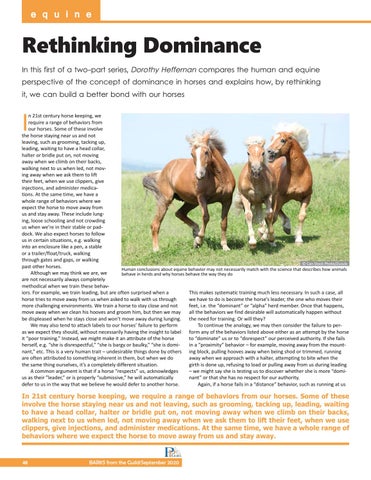e q u i n e
Rethinking Dominance In this first of a two-part series, Dorothy Heffernan compares the human and equine perspective of the concept of dominance in horses and explains how, by rethinking it, we can build a better bond with our horses
I
n 21st century horse keeping, we require a range of behaviors from our horses. Some of these involve the horse staying near us and not leaving, such as grooming, tacking up, leading, waiting to have a head collar, halter or bridle put on, not moving away when we climb on their backs, walking next to us when led, not mov ing away when we ask them to lift their feet, when we use clippers, give injections, and administer medica tions. At the same time, we have a whole range of behaviors where we expect the horse to move away from us and stay away. These include lung ing, loose schooling and not crowding us when we’re in their stable or pad dock. We also expect horses to follow us in certain situations, e.g. walking into an enclosure like a pen, a stable or a trailer/float/truck, walking through gates and gaps, or walking © Can Stock Photo/Zuzule past other horses. Human conclusions about equine behavior may not necessarily match with the science that describes how animals Although we may think we are, we behave in herds and why horses behave the way they do are not necessarily always completely methodical when we train these behav iors. For example, we train leading, but are often surprised when a This makes systematic training much less necessary. In such a case, all horse tries to move away from us when asked to walk with us through we have to do is become the horse’s leader, the one who moves their more challenging environments. We train a horse to stay close and not feet, i.e. the “dominant” or “alpha” herd member. Once that happens, move away when we clean his hooves and groom him, but then we may all the behaviors we find desirable will automatically happen without be displeased when he stays close and won’t move away during lunging. the need for training. Or will they? We may also tend to attach labels to our horses’ failure to perform To continue the analogy, we may then consider the failure to per as we expect they should, without necessarily having the insight to label form any of the behaviors listed above either as an attempt by the horse it “poor training.” Instead, we might make it an attribute of the horse to “dominate” us or to “disrespect” our perceived authority. If she fails herself, e.g. “she is disrespectful,” “she is bargy or baulky,” “she is domi in a “proximity” behavior – for example, moving away from the mount nant,” etc. This is a very human trait – undesirable things done by others ing block, pulling hooves away when being shod or trimmed, running are often attributed to something inherent in them, but when we do away when we approach with a halter, attempting to bite when the the same thing ourselves, it’s a completely different situation. girth is done up, refusing to load or pulling away from us during leading A common argument is that if a horse “respects” us, acknowledges – we might say she is testing us to discover whether she is more “domi us as their ”leader,” or is properly “submissive,” he will automatically nant” or that she has no respect for our authority. defer to us in the way that we believe he would defer to another horse. Again, if a horse fails in a “distance” behavior, such as running at us
In 21st century horse keeping, we require a range of behaviors from our horses. Some of these involve the horse staying near us and not leaving, such as grooming, tacking up, leading, waiting to have a head collar, halter or bridle put on, not moving away when we climb on their backs, walking next to us when led, not moving away when we ask them to lift their feet, when we use clippers, give injections, and administer medications. At the same time, we have a whole range of behaviors where we expect the horse to move away from us and stay away.
48
BARKS from the Guild/September 2020

















